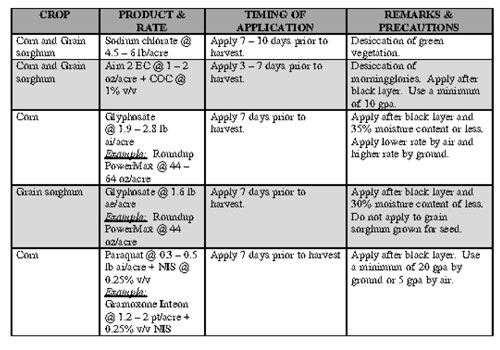Harvest Aids In Corn And Grain Sorghum
ALEXANDRIA, LA.
It is that time of the year when corn and grain
sorghum harvest is about to begin in earnest,
which puts the spotlight on harvest aids. The
question I hear most often is, “How can I kill the
johnsongrass and morningglories in my
corn/grain sorghum before I harvest?” There really
are not many options, but the options we
have will perform if they are applied correctly at
the correct time.

The primary benefit from applying a harvest
aid to corn or grain sorghum is desiccation of
green crop/weed material. However, do not expect
a harvest aid application to dry down the
crop and bring the moisture content down so
that you can harvest quicker. Harvest aids only
desiccate (brown and crispy) green material.
They don’t reduce the moisture content of the
corn or grain sorghum kernels. However, a harvest
aid should help harvesting efficiency and
increase combine speed because the amount of
green material ran through the combine is reduced.
It is important that a producer does not apply
a harvest aid to corn or grain sorghum until
after the grain has reached physiological maturity
and a specific moisture content. In both
corn and grain sorghum, black layer formation
is the most definitive sign of physiological maturity.
In corn, physiological maturity (black layer)
typically occurs two to three weeks after the kernel
dents. The starch layer in each kernel has
reached the cob and a black layer forms at the
base of the kernel. Please note that kernels near
the tip of the ear develop black layer earlier than
kernels near the base of the ear. Typically, grain
moisture content at this time ranges from 25 to
35 percent. Applying a harvest aid prior to black
layer or when grain moisture content is greater
than 35 percent may damage the grain.
Grain sorghum kernels at the top of the seed
head will mature before those at the bottom.
Typically, a kernel has reached black layer
when it appears pinched at the base and has a
black spot (black layer) where the grain was attached
to the seed head. At times, the moisture
content of black layer grain sorghum kernels
will exceed 30 percent. As a rule, it is important
to wait until the grain sorghum kernels have
reached 30 percent or less moisture or grain
can be damaged by the application.
Whether a producer is considering applying a
harvest aid to corn or grain sorghum, he/she
should collect numerous kernel samples from
the crop, determine if black layer has formed
and the moisture content of the grain. When applied
correctly, a harvest aid can increase harvesting
efficiency while decreasing potential
harvest troubles such as high foreign matter
content.
Below are products labeled for use as harvest
aids in Louisiana. Note that sodium chlorate,
Aim 2EC, and glyphosate are labeled for use in
corn and grain sorghum. However, paraquat
(Gramoxone Inteon or generic) is NOT labeled as
a harvest aid in grain sorghum. Δ
DR. DANIEL STEPHENSON: Weed Scientist,
LSU AgCenter